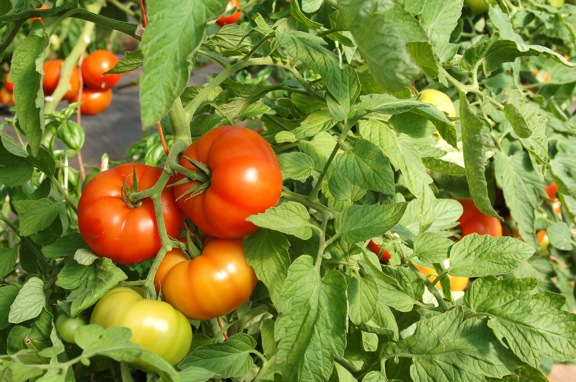SAVOR THE SEASON: North Country School gives helpful tomato-growing tips

At the top right are North Country School/Camp Treetops Director of Facilities and Sustainability John Culpepper and Assistant Farm Manager Gavi Mallory in the tomato greenhouse. (News photo — Andy Flynn)
LAKE PLACID – Growing a warm-weather crop such as tomatoes can be tricky in the higher elevations of the Adirondack Mountains, particularly at North Country School/Camp Treetops, which is 2,200 feet above sea level. If it can be done here, homeowners in the rest of Essex County should have no trouble.
Of course, most people don’t have a 30-by-90-foot greenhouse in their yard like they do at North Country School, which is 6 miles east of Lake Placid on state Route 73. The school is located on a rise that leads to neighboring mountains such as Pitchoff and Cascade.
For gardeners who know their USDA Plant Hardiness Zone Map, it’s zone 3 bordering on zone 2, according to John Culpepper, director of facilities and sustainability at North Country School/Camp Treetops. The lower the zone, the colder the climate. This map is the standard gardeners use to determine which plants are most likely to thrive at a particular location.
“That’s complicated by the fact that we’re often in clouds here, which makes growing tomatoes even more difficult,” Culpepper said.
In the world of tomatoes, there are generally two kinds: determinate and indeterminate.

Tomatoes at the end of the growing season in September 2014 at North Country School (News photo — Andy Flynn)
“A determinate tomato is one that a lot of people will call a patio tomato,” Culpepper said. “That’s a more common tomato in the North Country. It’s a squat thing, and it doesn’t tend to vine.”
Indeterminate tomatoes have to be trained by string or a trellis in order for them to be productive. They need to go vertically.
“The training system that we have here, the idea is that the tomatoes go all the way up and when they get tall enough, we lay all the tomatoes down at the same time, and they all go horizontal and then back up again,” Culpepper said.
The school’s tomato plants may be 20 to 25 feet long by September. They use strings from the ground to a metal bar 8 feet in the air to train the plants.
In all, there are about 10 different varieties in the greenhouse, including slicing, Juliet (plum) and cherry tomatoes.
All the tomato plants were started by seed in another greenhouse in April and transplanted about a month later. The ones in the greenhouse now were transplanted about four weeks ago.
They also grow cucumbers, peppers, okra and basil among the tomato plants.
“Basil and tomatoes are often planted together because they promote each other’s growth,” said Gavi Mallory, assistant farm manager at North Country School.
Mallory spends a lot of time keeping moisture away from the foliage, and she prunes the plants so there are no leaves touching the soil.
“We try to minimize the amount of moisture that is on the foliage of the tomatoes because a lot of tomato diseases are water borne and soil borne,” Mallory said. “We’re watering the soil so the roots have access to water while also minimizing how wet the leaves get.”
They also try to keep few leaves close to the ground because that tends to encourage pests. The kinds of pests they get include aphids and thrips.
Neutral soils work well for tomatoes, but they need an enormous amount of water. The school’s watering system is set up so all the tomatoes are watered by drip tape on the ground next to the plants.
Culpepper tried to be encouraging when talking about a homeowner growing tomatoes and other warm-weather crops.
Typically a homeowner wouldn’t go to the trouble of trellising their tomatoes. Instead, they would grow a patio tomato in planters or in the ground.
“Planters, especially dark-colored planters, are nice because the soil in that planter can heat up more quickly than soil in the ground,” he said. “For the average homeowner, often you will find little microclimates in a yard. If there’s an area where it’s up against a concrete wall or some area that retains some heat, that can be a particularly good place to grow tomatoes, peppers, eggplants, things like that.”
North Country School harvests a couple of thousand pounds of tomatoes every year for use at the school and camp.
“We eat a lot of tomatoes,” Culpepper said. “We grow an Italian tomato that has a low moisture content, and those are processed into sauce. At the end of the season, there’s lots of effort to make sauce and freeze it, and then we’ll use that through the winter months.”
- Tomatoes at the end of the growing season in September 2014 at North Country School (News photo — Andy Flynn)






